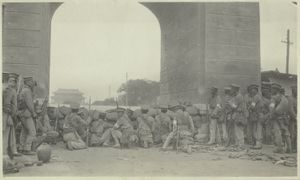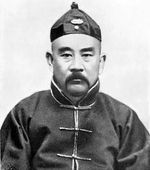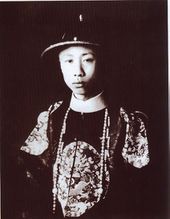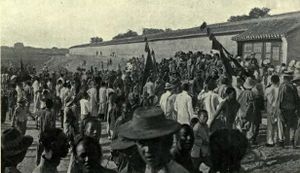استعادة المانشو
| استعادة المانشو | |||||||
|---|---|---|---|---|---|---|---|
| جزء من عصر أمراء الحرب | |||||||
 القوات الجمهورية تقاتل لاستعادة المدينة المحرمة في 12 يوليو 1917، بعد محاولة ژانگ شون استعادة الحكم الامبراطوري | |||||||
| |||||||
| المتحاربون | |||||||
|
|
| ||||||
| القادة والزعماء | |||||||
|
|
| ||||||
استعادة المانشو Manchu Restoration في يوليو 1917 كانت محاولة لاستعادة الملكية في الصين من قِبل الجنرال ژانگ شون، الذي استولى جيشه على بكين ولفترة وجيزة أعاد تنصيب آخر امبراطور من أسرة تشينگ، پويي، على العرش. استمرت الاستعادة أياماً معدودات، من 1 يوليو حتى 12 يوليو، وسرعان ما دحرتها القوات الجمهورية.
خلفية
المواجهة بين الرئيس لي يوانهونگ و رئيس الوزراء دوان چيروي حول الانضمام إلى قوى الحلفاء في الحرب العالمية الأولى وإعلان الحرب على ألمانيا، أدت إلى قلاقل سياسية في بكين في ربيع 1917.[1]
غادر الحكام العسكريون بكين بعد طرد دوان چيروي كرئيس وزراء. وقد تجمعوا في تيانجين، داعين قوات المقاطعات للتمرد على "لي" والاستيلاء على العاصمة، بالرغم من معارضة سلاح البحرية والمقاطعات الجنوبية. ورداً على ذلك في 7 يونيو 1917، طلب لي من الجنرال ژانگ شون أن يتوسط. فطلب الجنرال ژانگ حل البرلمان، الذي اعتبره لي غير دستوري.
الاستعادة
في صبيحة 1 يوليو 1917، استغل الجنرال الملكي ژانگ شون القلاقل ودخل العاصمة، معلناً استعادة پويي امبراطوراً على الصين في الساعة الرابعة صباحاً بموكب صغير وأحيى ملكية تشينگ التي كانت الصين قد تخلت عنها في 12 فبراير 1912. خضعت شرطة العاصمة للحكومة الجديدة.[1][2] ونشر الجنرال شو، لاحقاً، مرسوم استعادة، زوّر فيه موافقة رئيس الجمهورية، لي يوانهونگ.[3] He was also supported by several other officials, including Beiyang General Jiang Chaozong,[4] former Qing war minister Wang Shizhen,[5][6] civil affairs minister Zhu Jiabao,[6] and diplomat Xie Jieshi.[7]
Over the next 48 hours, edicts were proclaimed in an attempt to shore up the restoration, to the astonishment of the general public. On July 3, Li fled the presidential palace with two of his aides and took refuge in the embassy district, first in French legation and later in the Japanese embassy.[8]
Before taking refuge in the Japanese embassy, Li had taken certain measures, including leaving the presidential seal in the Presidential Palace, appointing Vice President Feng Guozhang as Acting President, and restoring دوان چيروي as Premier, in an attempt to enlist them in the defense of the republic.[8]
Duan immediately took command of the republican troops stationed in nearby Tianjin.[9] On July 5, 1917, his troops seized the Beijing-Tianjin railway 40 kilometers from the capital.[10] On the same day, General Zhang left the capital to meet the republicans, his forces further bolstered by Manchu reinforcements.[10] Zhang was faced with overwhelming odds; almost all of the Northern Army was opposed to him and he was forced to withdraw after republican troops seized control of the two main railway lines to the capital.[10]
On the ninth day of the Restoration, General Zhang resigned from his appointed positions, retaining only the command of his troops in the capital, which were surrounded by republican forces.[11] The restored imperial court prepared an edict of abdication for پويي، but fearful of Zhang's royalist forces, did not dare proclaim it.[11] The imperial court began secret negotiations with republican forces to prevent an assault on the city, even asking the foreign legations to mediate between the parties.[11] The uncertainty over the imperial court's own fate and that of General Zhang caused negotiations to fall apart. The republican generals announced a general assault on the positions of the monarchists on the morning of July 12.[12]
The attack began the next day, with royalists troops entrenched on the wall of the Temple of Heaven.[12] Shortly after the fighting began, negotiations resumed, resulting in the royalists giving up their positions. General Zhang, dismayed, fled to the legations quarter.[12] Once General Zhang had fled, the royalist troops called for a ceasefire, which was immediately granted.[12]
الأعقاب
The military failure of the royalist troops left the Qing court and imperial family in a precarious position with the republican government suspicious of the Qing remnants.[12]
President Li refused to return to his post, leaving it in the hands of Feng Guozhang.[1][12] The departure of Li from the republican leadership allowed Duan to take charge of the government, and a month after the recapture of capital, on August 14, 1917, China declared war on Germany as Duan had originally wished, without opposition from Li. The withdrawal of Li led to the strengthening of military cliques in northern China and left the already-fractured central government in the hands of the Feng Zhili-Anhui Clique dominated by Duan. The weakening of the central government led to the further fragmentation of China into the warlord era and the rival government of Sun Yat-sen gaining popularity and traction in the south.
المصادر
الهامش
- ^ أ ب ت Nathan (1998), p. 91
- ^ Putnam Weale (1917), p. 355
- ^ Putnam Weale (1917), p. 356
- ^ Sergei Leonidovich Tikhvinsky (1983). Modern History of China. Progress Publishers. p. 735. Retrieved 2016-09-24.
- ^ Xu Youchun. People's Republic of China Zeng Dictionary (revised edition). Hebei People's Publishing House. 2007. ISBN 978-7-202-03014-1.
- ^ أ ب Liushou Lin. Republic of China Official Chronology. Zhonghua Book Company. 1995. ISBN 7-101-01320-1.
- ^ Yamamuro, Shinichi (2005). Manchuria Under Japanese Domination. University of Pennsylvania Press. ISBN 0-8122-3912-1
- ^ أ ب Putnam Weale (1917), p. 360
- ^ Putnam Weale (1917), p.364
- ^ أ ب ت Putnam Weale (1917), p. 366
- ^ أ ب ت Putnam Weale (1917), p. 367
- ^ أ ب ت ث ج ح Putnam Weale (1917), p. 368
المراجع
- Nathan, Andrew (1998). Peking Politics 1918-1923: Factionalism and the Failure of Constitutionalism. Center for Chinese Studies. ISBN 978-0-89264-131-4. (320 pages)
{{cite book}}: CS1 maint: postscript (link) - Putnam Weale (1917). The fight for the republic in China. Dodd, Mead and Company. (490 pages)
{{cite book}}: CS1 maint: postscript (link)





